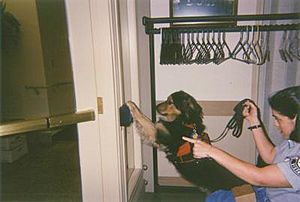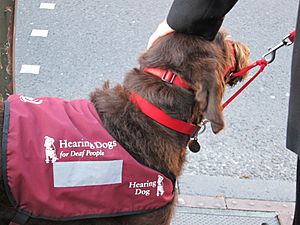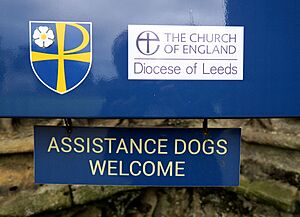Assistance dog facts for kids
An assistance dog is a special dog trained to help people with disabilities. In the United States, they are often called service dogs. These amazing dogs learn many tasks to support their human partners. Many are trained by special organizations. Others are trained by their owners, sometimes with help from a professional dog trainer.
Contents
What is an Assistance Dog?
The term 'assistance dog' is used all over the world for dogs that help people with disabilities. These dogs are specifically trained to do tasks that make life easier for their handlers. Assistance Dogs International, a group that connects assistance dog providers globally, uses this term. They are working to make sure everyone uses the same words. This helps people understand the important role these dogs play.
What Makes a Dog an Assistance Dog?
For a dog to be called an assistance dog, it needs to meet certain rules:
- The dog's human partner must have a disability. This means they meet the legal definition of disability in their country.
- The dog must be trained for specific tasks to help with that disability. For example, they might open doors, warn about low blood sugar, or guide someone who cannot see well.
- The dog must be very well-behaved in public. They need to be safe around people and healthy.
- Some assistance dogs wear special vests or harnesses. These often say "Assistance Dog" or "Service Dog". However, wearing one is not always required by law.
Each country has its own specific laws. But these general rules are recognized around the world.
How Are Assistance Dogs Trained?
Assistance dogs are often trained by charities or special organizations. These groups then match a trained dog with a person who needs help. This usually happens when the dog is about two years old. More and more, people with disabilities are also training their own assistance dogs. They choose a puppy, often called a 'prospect', and train it themselves.
There are different ways to train an assistance dog. But all future assistance dogs go through similar steps.
Choosing the Right Dog
Assistance dog candidates are chosen very carefully. Trainers look for good health, a calm personality, and other helpful traits. Large organizations, like The Guide Dogs for the Blind, even breed their own puppies. This helps them get healthy dogs with the right qualities. Some people choose puppies from good breeders. Others might train a dog that is already part of their family. There was even a TV show called "Rescue Dog to Super Dog". It showed how shelter dogs could be chosen and trained as assistance dogs.
Learning to Be Social
The first part of a puppy's life is usually about learning to be social. This is not formal training yet. Big organizations often use puppy foster parents. These families raise the puppy in a normal home. The puppy gets used to everyday sights, sounds, and smells. They learn to be clean and confident. Owners who train their own dogs also focus on this. They make sure their puppy has fun experiences and learns to be comfortable everywhere.
Special Task Training
Once a puppy is old enough, it starts its special training. This includes learning specific tasks. These tasks are what make them unique assistance dogs. In Europe, an assistance dog usually needs to know at least three special tasks. These tasks must help with the owner's disability. In the USA, a handler might only be asked if they have a disability. They might also be asked what tasks their dog performs to help them.
The tasks a dog learns depend on the handler's disability. There are so many different tasks a dog can be trained to do! They might pick up dropped items. They could even take laundry out of a washing machine. Some dogs provide deep pressure therapy for people with autism.
Good Manners and Public Access
While learning their special tasks, assistance dogs also learn how to behave well in public. They learn to be polite and calm. Large organizations have their own training methods for this. Owners who train their own dogs also have different ways. Many owner-trainer groups suggest following dog obedience programs. These programs help dogs learn high standards of obedience. After that, dogs often take a Public Access Test. This test checks if a dog can behave correctly in public places. This includes places where pets are not usually allowed, like supermarkets or restaurants.
Types of Assistance Dogs
Here are some common types of assistance dogs:
- Guide dogs help people who are blind or cannot see well.
- Hearing dogs, also called signal dogs, help people who are deaf or hard of hearing.
- Mobility assistance dogs help people with physical challenges.
- Medical response dogs can help with medical conditions.
- Psychiatric service dogs help people with mental health conditions.
- Autism Assistance dogs help people with autism.
There are also facility dogs. These dogs work with professionals to help many people.
- Courthouse facility dogs work with legal professionals. They often help crime victims or witnesses during legal cases.
- Facility dogs in schools are usually handled by special education teachers. They help students interact and learn.
- Facility dogs in hospitals are handled by healthcare workers. They help patients recover or manage their symptoms.
In the United States, assistance dogs are mainly split into two groups: service dogs and facility dogs. Service dogs are trained to do tasks for one person with a disability. They are allowed in most public places. Facility dogs are used by professionals to help many different people.
Facility Dogs vs. Therapy Dogs
Facility dogs and therapy dogs both help people. They might even work in similar places, like hospitals. But there are important differences between them.
Facility dogs are trained by special assistance dog organizations. Or they are trained by their owners for a long time, usually 18 to 24 months. They must pass very hard tests to graduate. Therapy dogs, on the other hand, are trained by their owners. They do not always need to take special obedience classes. The tests for therapy dogs are usually not as hard as those for facility dogs.
If you have a therapy dog or a facility dog, you need permission to bring them into places. They do not have the right to go everywhere pets are not allowed. You also might have to pay pet fees for them.
Images for kids
See also
 In Spanish: Perro de asistencia para niños
In Spanish: Perro de asistencia para niños






